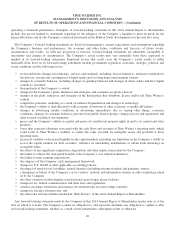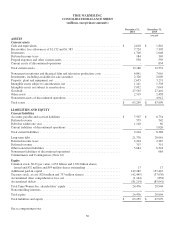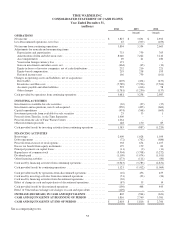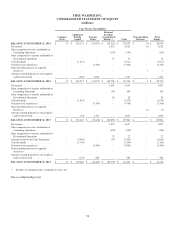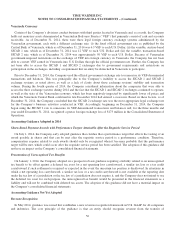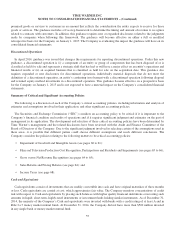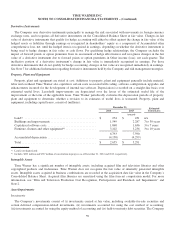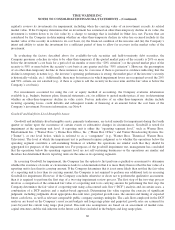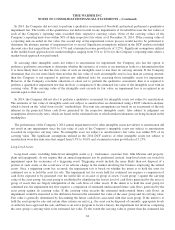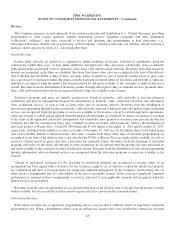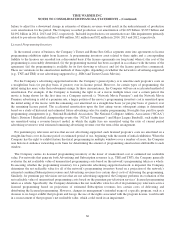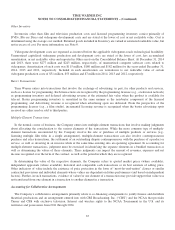Time Magazine 2014 Annual Report Download - page 73
Download and view the complete annual report
Please find page 73 of the 2014 Time Magazine annual report below. You can navigate through the pages in the report by either clicking on the pages listed below, or by using the keyword search tool below to find specific information within the annual report.TIME WARNER INC.
NOTES TO CONSOLIDATED FINANCIAL STATEMENTS – (Continued)
promised goods or services to customers in an amount that reflects the consideration the entity expects to receive for those
goods or services. The guidance includes a five-step framework to determine the timing and amount of revenue to recognize
related to contracts with customers. In addition, this guidance requires new or expanded disclosures related to the judgments
made by companies when following this framework. The guidance will become effective on either a full or modified
retrospective basis for the Company on January 1, 2017. The Company is evaluating the impact the guidance will have on its
consolidated financial statements.
Discontinued Operations
In April 2014, guidance was issued that changes the requirements for reporting discontinued operations. Under this new
guidance, a discontinued operation is (i) a component of an entity or group of components that has been disposed of or is
classified as held for sale and represents a strategic shift that has had or will have a major effect on an entity’s operations and
financial results or (ii) an acquired business that is classified as held for sale on the acquisition date. This guidance also
requires expanded or new disclosures for discontinued operations, individually material disposals that do not meet the
definition of a discontinued operation, an entity’s continuing involvement with a discontinued operation following disposal
and retained equity method investments in a discontinued operation. This guidance became effective on a prospective basis
for the Company on January 1, 2015 and is not expected to have a material impact on the Company’s consolidated financial
statements.
Summary of Critical and Significant Accounting Policies
The following is a discussion of each of the Company’s critical accounting policies, including information and analysis of
estimates and assumptions involved in their application, and other significant accounting policies.
The Securities and Exchange Commission (“SEC”) considers an accounting policy to be critical if it is important to the
Company’s financial condition and results of operations and if it requires significant judgment and estimates on the part of
management in its application. The development and selection of these critical accounting policies have been determined by
Time Warner’s management and the related disclosures have been reviewed with the Audit and Finance Committee of the
Board of Directors of the Company. Due to the significant judgment involved in selecting certain of the assumptions used in
these areas, it is possible that different parties could choose different assumptions and reach different conclusions. The
Company considers the policies relating to the following matters to be critical accounting policies:
• Impairment of Goodwill and Intangible Assets (see pages 60 to 61);
• Film and Television Production Cost Recognition, Participations and Residuals and Impairments (see pages 65 to 66);
• Gross versus Net Revenue Recognition (see pages 64 to 65);
• Sales Returns and Pricing Rebates (see page 64); and
• Income Taxes (see page 68).
Cash and Equivalents
Cash equivalents consist of investments that are readily convertible into cash and have original maturities of three months
or less. Cash equivalents are carried at cost, which approximates fair value. The Company monitors concentrations of credit
risk with respect to Cash and equivalents by placing such balances with higher quality financial institutions or investing such
amounts in liquid, short-term, highly-rated instruments or investment funds holding similar instruments. As of December 31,
2014, the majority of the Company’s Cash and equivalents were invested with banks with a credit rating of at least A and in
Rule 2a-7 money market mutual funds. At December 31, 2014, the Company did not have more than $500 million invested
in any single bank or money market mutual fund.
57




